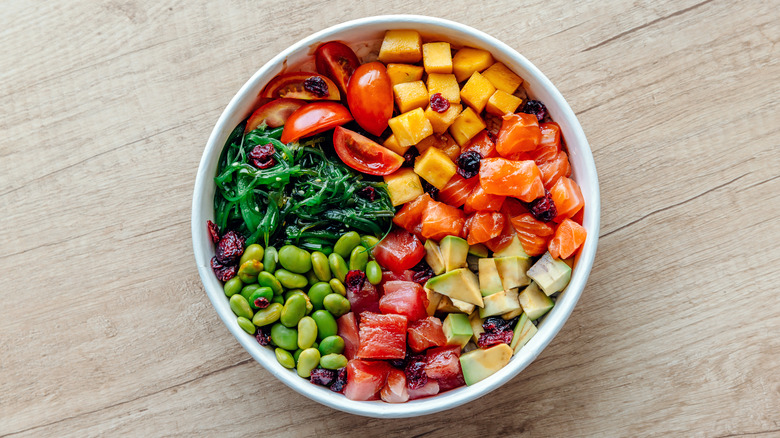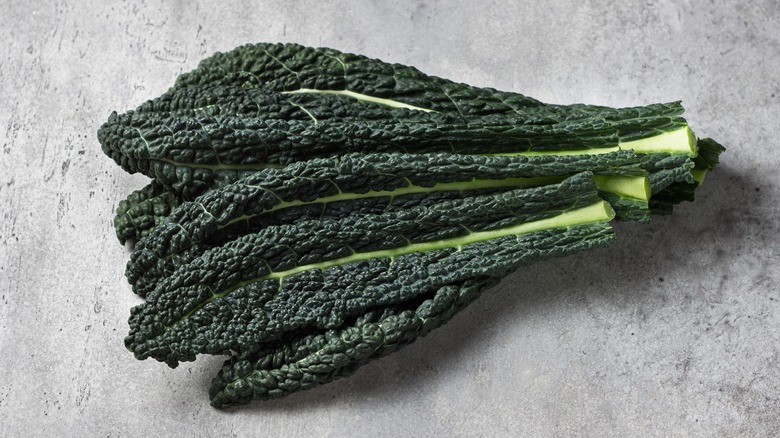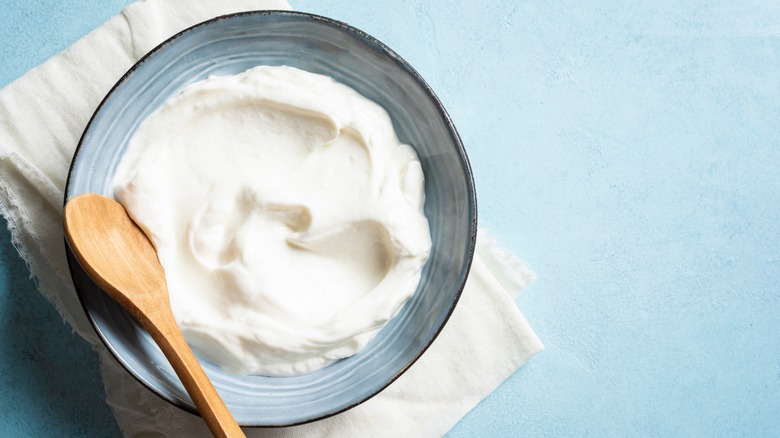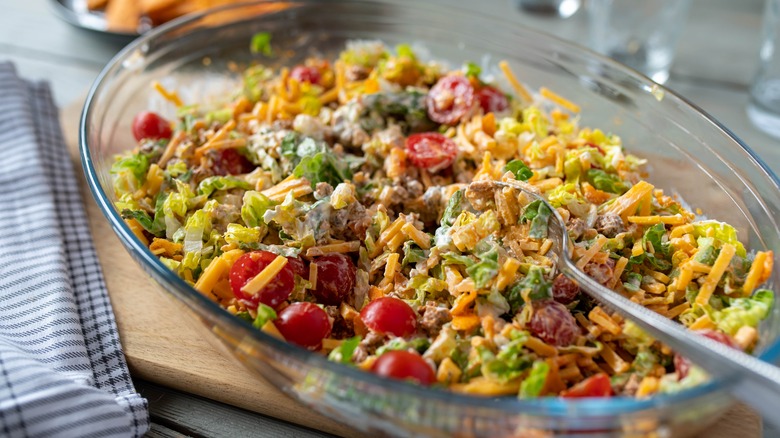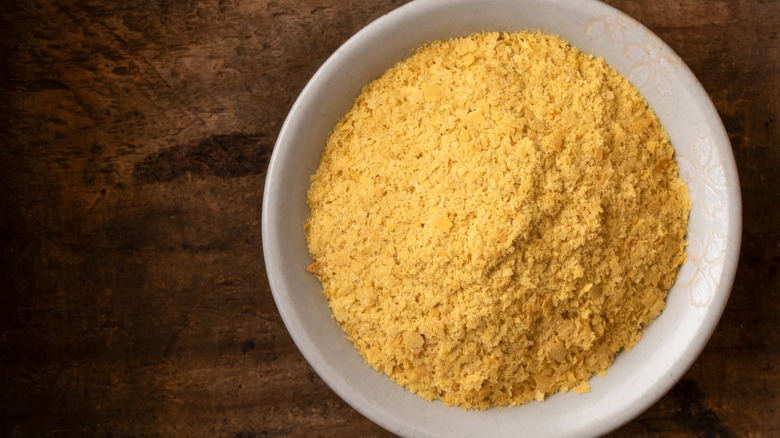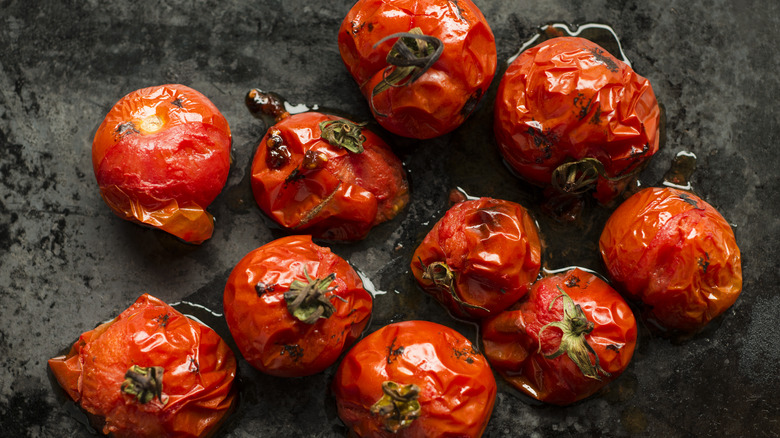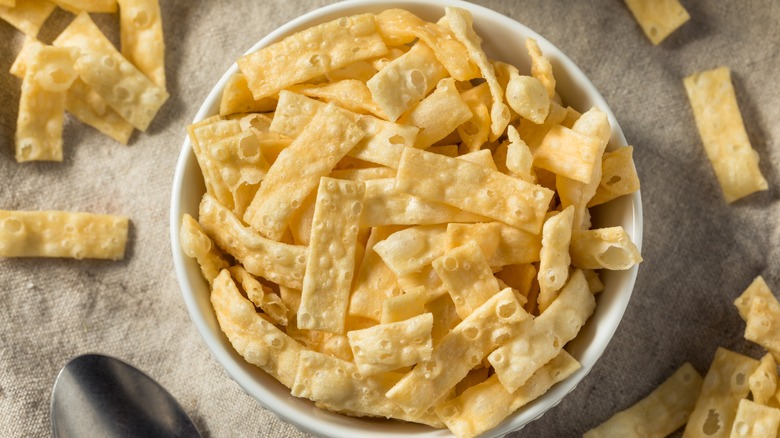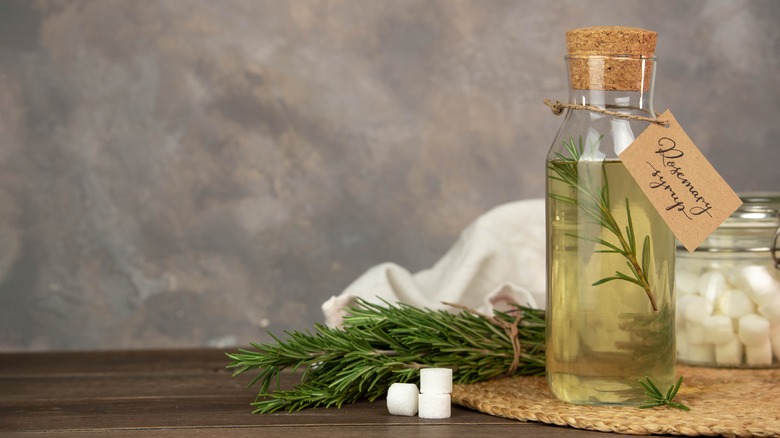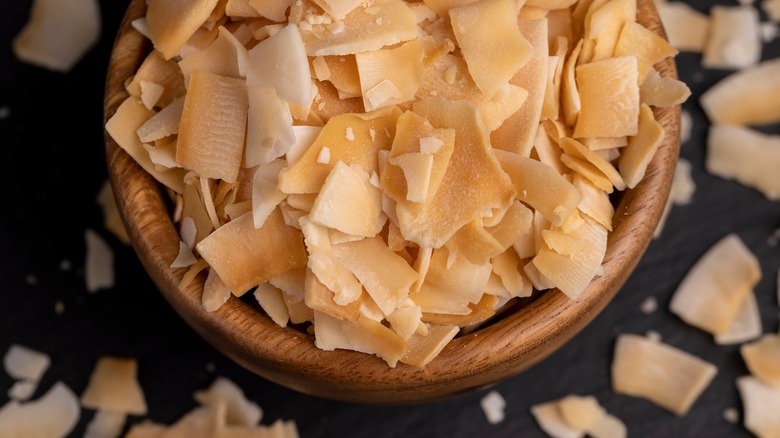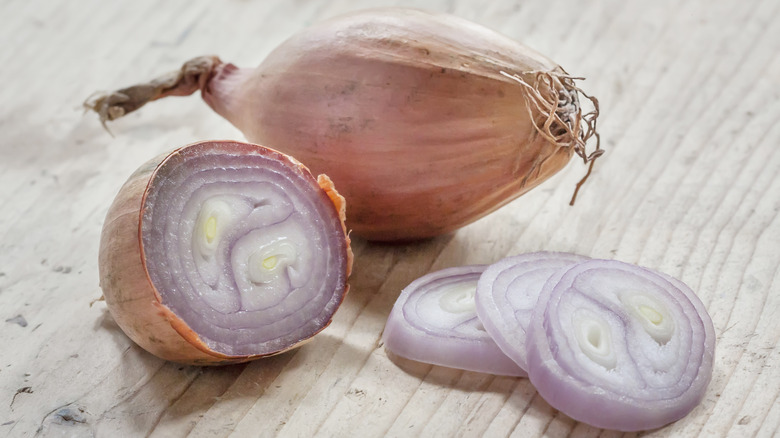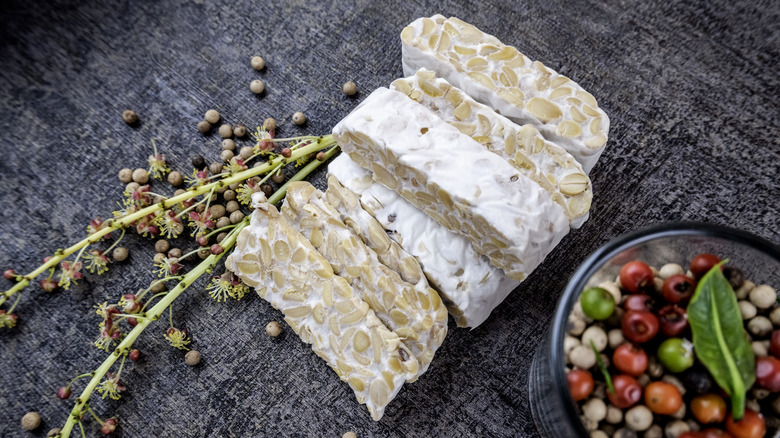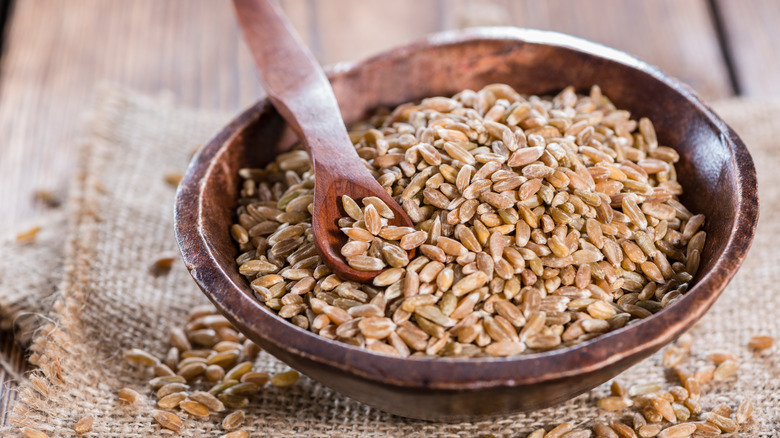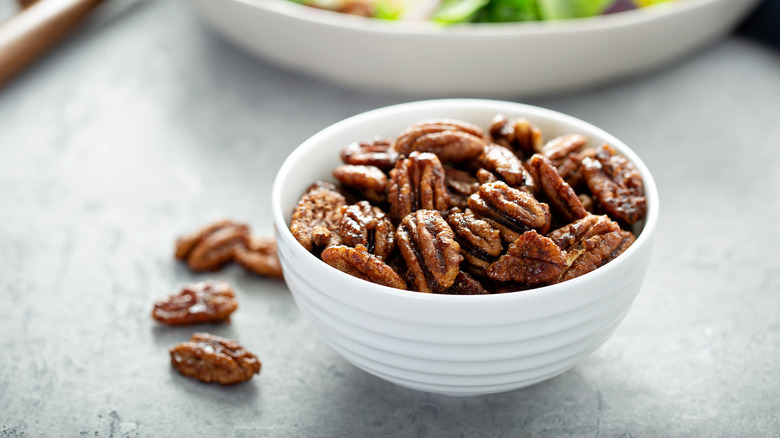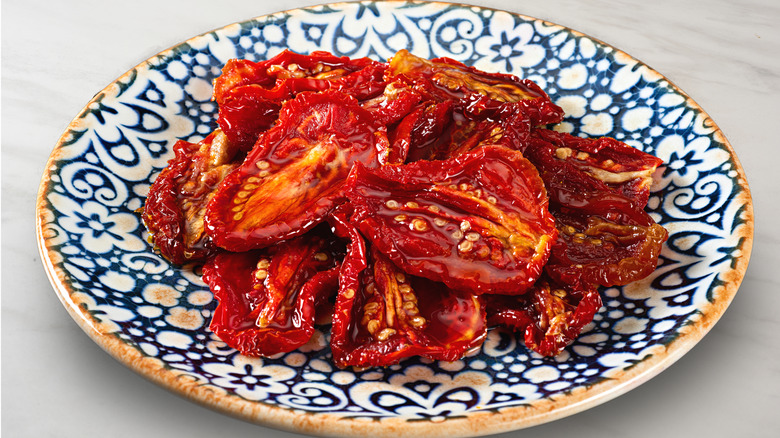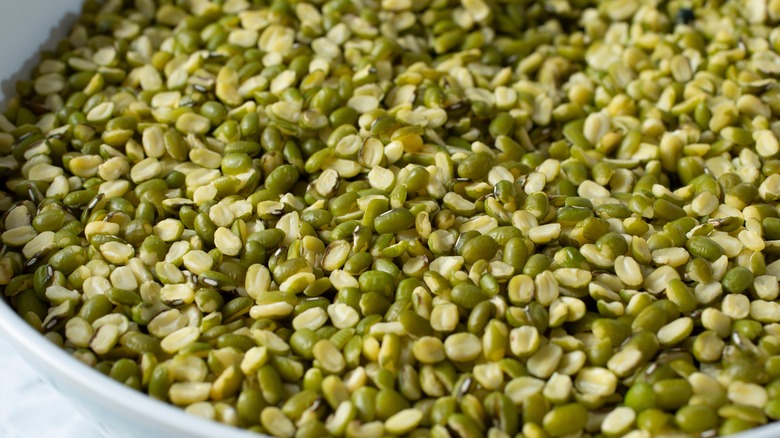14 Ingredient Swaps That Will Make Your Salad Much Better
We love salads. That may sound like a boring thing to say, but if you've ever had a really good salad, you'll know what we mean. Like any well-made meal, a good salad is a harmony of flavors and textures, balancing contrasting tastes and consistencies to make each bite multifaceted and rich. Unfortunately, though, most of us make salads in the same way every time, using the same old stuff from our refrigerators, without considering that a simple ingredient swap might be the key to unlocking these flavor and texture dynamics that we all crave.
Well, not anymore. We're here to show you all of the ingredient swaps you need to take your salads to the big leagues. Simple swaps like changing your standard greens for alternative veggies, or swapping dried fruits for an alternative form of sweetness, can add depth and create new mouth feels throughout your salad. Other swaps, like opting for nutritional yeast instead of parmesan, can make them vegan-friendly without compromising taste. To get the lowdown on ingredient swaps, we spoke to Lindsey Neumeyer, the owner of A Recipe for Fun, a food blog specializing in seasonal entertaining recipes. She's worked at several restaurants in the Central Florida tourism industry, and has made more salads during her career than most of us.
1. Leave out the lettuce and use Tuscan kale
Crisp, moist, and delicately flavored, lettuce adds bulk and crunchiness to salads without imposing on any other ingredients. As an alternative to lettuce, kale has snuck up as a go-to salad green — but the type of kale you choose matters. "Kale is hearty and substantial, but it can also be bitter in taste which can overpower other salad ingredients," warns Lindsey Neumayer.
The solution, though, is not to skip kale, but to pick the type you use wisely. "I love using lacinato kale (also called dino kale or Tuscan kale) over curly kale for folks who don't think they'll like the taste of kale. It's much less bitter than curly kale," says Neumayer. Tuscan kale generally has dark-green leaves that have a slightly bumpy texture, and thick jade stems that run through them. As with normal kale, you'll need to remove these stems before throwing the leaves into your salads, as they can be a little tough. Whereas regular curly kale is bitter, Tuscan kale has a sweetness to each bite that pairs well with savory flavor elements in salads.
2. Swap the mayo in your dressing for Greek yogurt
Mayonnaise-based dressings work wonders in salads. When they're made well, they add creaminess without making things too gloopy and are sharp and bright instead of dense and eggy. However, mayonnaise can get pretty heavy, and going for Greek yogurt can be a great alternative. "I love swapping out mayo for Greek yogurt, especially in a blended dressing," says Lindsey Neumayer. Neumayer especially likes popping it in a blue cheese dressing, where the tangy hit of the cheese pairs wonderfully with the slight acidity of the yogurt.
You can also lean into the Greek flavors suggested by the use of yogurt. Try whipping up a salad dressing made with fresh dill, crushed garlic, olive oil, Greek yogurt, and lemon juice for a fresh, zesty affair. If you don't have Greek yogurt, you can also swap your mayo for buttermilk. While buttermilk is way thinner than mayo, and will produce a thinner dressing, it'll also add a tart acidity that works especially well with sweet salad ingredients, like dried fruits or fresh cherries.
3. For taco salads, use tofu instead of beef
A taco salad demands ground beef, and trying to make one without it is kinda futile. If you're catering for plant-based guests, though, or just wanna make a salad that isn't so heavy, try tofu instead. "Marinated extra-firm tofu is a great replacement for ground meat in something like a taco salad," says Lindsey Neumayer. If you get your marinade just right, it's hard to tell the difference — but tofu can also give an extra layer of nuttiness to your salad that deepens its flavor.
Making marinated tofu that emulates ground beef is super easy, too. All you need to do is crumble up your extra-firm tofu, pour on an umami-rich marinade made from vegan beef bouillon, soy sauce, and maybe a little Marmite and Worcestershire sauce if you want some funkier, deeper flavors, and wait. Once it's all soaked up, fry off your tofu until it's browned, and throw it into your salad. For extra flavorful tofu, you can even marinate it after cooking, too. Doing this will thicken the marinade even further and add more flavor to your tofu — you won't be able to tell it's not beef, y'all.
4. Instead of parmesan, use nutritional yeast
Plant-based food lovers will likely be well aware of the power of nutritional yeast, but it's time for everyone else to get with the program. Nutritional yeast can make a perfect substitute for parmesan in salads, thanks to its cheesy taste and flaky texture. It has all of the umami of parmesan cheese, but there's a slight note of earthiness and nuttiness that distinguishes it, and which provides a slightly deeper and less salty flavor.
You can use nutritional yeast exactly how you would parmesan or any other hard cheese, by scattering it over your salad before you're about to serve it. You can also use it to coat your croutons, giving each crispy bite maximum flavor. While you can add it fairly generously, Lindsey Neumayer recommends you exercise a little caution. "Generally, you can't go overboard with nutritional yeast unless you're dumping spoonfuls on your salads, which could cause your salads to taste dry or gritty," she says. Doing this will also likely overpower your salad with the nutritional yeast's taste, which you likely don't want. A gentle scattering of nooch will do.
5. Rather than fruit for sweetness, use roasted vegetables
Berries and stone fruit can bring sharpness and sweetness to a lot of salad dishes, where they work against the savory flavors and add layers to the dish. If you want something a little more mellow and complex, though, roasted vegetables are the way to go. "Roasted veggies, like oven-roasted tomatoes or carrots, are also great swaps for fruit when you want sweetness," explains Lindsey Neumayer. "The natural sugars in the veggies caramelize during low-and-slow-roasting, making them taste sweet!"
Adding roasted vegetables to your salad also introduces a hint of smokiness, which works particularly well in protein-heavy recipes. When combined with chicken, pork, or even beans, this smoky sweetness makes the proteins taste richer and more vibrant. As well as tomatoes and carrots, roasted bell peppers, zucchini, and Brussels sprouts are all awesome options that each bring their own flavor profile. Roasted Brussels sprouts, for example, add a nutty, earthy sweetness, whereas roasted bell peppers will bring a little more acidity to the table. You don't need to roast your vegetables yourself, either: Canned or jarred roasted veggies can add flavor in mere seconds.
6. Leave out croutons and use wonton strips
Croutons aren't the only thing that can bring crunch to a salad — and wonton strips might make yours even better. "Wonton strips are wonderful crouton replacements," says Lindsey Neumayer. These small strips, made from fried wonton wrappers, bring an intense crispiness to the table. Their thin consistency increases their crunch, creating a greater contrast with your softer salad ingredients. Like croutons, they can also be made at home pretty easily, and you can season them with any herbs and spices you like.
Can't find any wonton strips? Don't worry: Tortilla chips can also create some incredible crunch. Regular tortilla chips bring a salty smack to your salad, and like wonton strips, they have a thinness that stops you from risking breaking your teeth, as can sometimes happen with larger, staler croutons. Plus, when you opt for tortilla chips, you open your salad up to a world of flavors. Grab a bag of spicy tortilla chips to make your salad a little more fiery, or go for lime-flavored chips to give it a citrusy note.
7. Skip the honey in your dressing and use infused simple syrups
There are several ways to add sweetness to a dressing, and a lot of people tend to use honey. Honey is a popular choice thanks to its mellow sweetness, gentle floral flavor, and ability to mix into a dressing without leaving any solid particles. "My absolute favorite trick is using simple syrups when making dressings," she says. "Infused simple syrups help deepen the flavor of dressings, especially when you're using seasonal ingredients, like blood oranges in a vinaigrette."
For those of you scratching your heads wondering what simple syrup is and how you're going to make it, you'll be pleased to hear that it's a fairly basic concoction of sugar and water. The two are mixed together in a 1:1 ratio, heated until the sugar dissolves, and left to cool. As Neumayer mentions, though, the fun comes when you infuse your syrup with various flavors. To do so, you just have to leave your ingredients to steep in your syrup as it cools, for about half an hour or so (or longer if you want a more intense flavor). As well as citrus fruits, herbs are awesome choices to infuse with syrup and whole spices, like cinnamon or star anise, can also give it a real punchiness.
8. Toasted coconut shavings can replace croutons
Bored of using croutons in your salads? Sub in toasted coconut shavings instead, and unlock a whole new world of flavor. This nifty swap is a favorite of Lindsey Neumayer's, and improves your salads in several different ways. The most important improvement, of course, is in its taste. Toasted coconut shavings add a nutty, sweet, caramel-like note to salads that work in dishes that are both deeply savory and light and zesty. Their crispness also creates little bursts of textual contrast throughout your salad.
Toasted coconut shavings also distribute way more evenly than croutons do. Because they're so small, they work their way into every corner of your salad, providing a more even flavor and texture throughout. As an extra bonus, using shavings instead of croutons is a great way to create crunch while keeping things gluten-free. To keep them as versatile as possible, try to use unsweetened coconut shavings, so that they don't make your salad taste like a coconut-flavored candy bar. You can then control any sweetness you add through your other ingredients or dressing. Making toasted coconut shavings at home is pretty easy, too, by pan-frying them or toasting the coconut shavings in the microwave.
9. Leave the garlic out of your vinaigrette and use shallots instead
Garlic is a common ingredient in classic French vinaigrette recipes, and it's easy to see why. Chopped or grated garlic infuses vinaigrettes with a sharp, spicy flavor and rich aroma that makes any salad more flavorful. However, using even just a little too much garlic can make it the dominant flavor — which is why we love using shallots instead. "Shallots are perfect to use in salad dressings, they are like the love child of an onion and garlic, bringing the best of both ingredients without being too overpowering," states Lindsey Neumayer.
Shallots have a gentle sweetness that rounds out their flavor slightly more than garlic, with an oniony punch that enlivens any vinaigrette. Because they're more delicate than both onions and garlic, shallots don't take over in a vinaigrette, but instead work to add an undertone to your other flavors. You can also use a combination of garlic and shallots, giving your vinaigrette the best of both worlds. However, if you're electing to do this, Neumayer recommends using a little more shallots than garlic, so that you don't lose the shallot flavor.
10. Instead of chicken, use tempeh
There's no denying it: Plain old chicken breasts can get pretty boring in salads. That's why Lindsey Neumayer likes to mix it up with tempeh. "Tempeh is my go-to for meatless salads," she says, with the protein bringing a lot more to your dish than you'd think. While tempeh is commonly confused for tofu, there are a few differences between the two. Tempeh is commonly made from soybeans, which are processed, fermented, and formed into solid blocks. Unlike tofu, though, it's always firm, and its nutty flavor is slightly more prominent. Luckily, this nutty flavor pairs well with most standard salad ingredients.
Just like chicken, tempeh has a firm texture — and it's exceptionally good at taking on other flavors. Tempeh can be marinated like any other protein, and can make your salad way more flavorful. For a sweet-savory effect, try making teriyaki tempeh and tossing it into a zesty cabbage salad. Alternatively, allow your tempeh to bathe in a mixture of Italian herbs, olive oil, balsamic vinegar, and garlic to give it a Mediterranean feel. Don't forget to cook your tempeh, either. A key difference between tempeh and tofu is that you can't eat the former ingredient raw, and its taste and texture will be pretty terrible if you don't.
11. Remove some of your lettuce and add farro as a base
Are you sick of all of your salads being so heavy on the lettuce, but can't figure out what to use instead? Lindsey Neumayer has got you covered, with a quick salad upgrade that employs farro. "Whenever I get bored with salads, I love switching up half of the base of lettuce for grains," says Neumayer. By swapping out some of the leaves and putting in farro, Neumayer states that you can turn your salad into a "bowl-style" affair, making it more substantial and improving its flavor.
Farro is an ancient grain that has a somewhat similar flavor to brown rice. Its nutty, earthy taste adds way more depth to salads than just using lettuce or other salad leaves. Its texture, meanwhile, is pleasingly chewy, making it a good contrast to crunchier ingredients. Plus, farro is a great source of fiber, protein, and important minerals like iron and magnesium, making your salads even more nutritious.
Can't get your hands on any farro? Never fear. Neumayer says that this lettuce swap can be performed with pretty much any grain you have in your kitchen, from regular rice to quinoa. You can also use orzo if you like.
12. Rather than dried cranberries, use candied nuts
A handful of dried cranberries is a reliable addition to salads. They're far from the only sweet ingredient you can add, though. "Candied nuts are also great options for bringing a pop of sweetness to salads," says Lindsey Neumayer — and we have to agree. While dried cranberries can bring tartness and squish to salad, they don't quite have the sugary intensity that candied nuts can bring. That sweetness (which helps to highlight savory flavors in salads, as well as sweet ones) is combined with a shattering crunch and the taste of each nut, which all come together to level up your salad.
Candied nuts aren't just a vehicle for sweetness, though: They can also be a vehicle for loads of other flavors. Adding a spice blend to your candied nuts will give your salad extra warmth. Throwing in some herbs will also make your salad way more dynamic, giving it floral and earthy notes. Be wary of over-flavoring your candied nuts, though: They tend to be pretty punchy anyway, and infusing them with loads of extra tastes will just cause them to dominate your other ingredients.
13. Skip the meat and use sun-dried tomatoes instead
Not every salad has to have meat, and in fact, a lot of the time it can drag down your dish. Adding plain chicken or turkey to a salad may give it a protein boost, but it can also make things taste way more plain and boring. Thankfully, Lindsey Neumayer has a solution. "Umami-rich ingredients like sun-dried tomatoes are a great swap for meat," she advises. These tomatoes take the umami-packed power of regular tomatoes and crank things up even further, with the drying process leaving them with four times the amount of glutamates. It's these glutamates that give them their savoriness and meatiness, allowing them to act as a meat substitute.
Sun-dried tomatoes also give your salad a juicy quality, thanks to their chewiness. Plus, the oil that they come packed in can make a great addition to your dressing or vinaigrette, and will imbue it with all of those wonderful savory notes. It's worth remembering that sun-dried tomatoes won't provide the same level of protein that meat will, so you may want to think about other ways that you can ensure that your salad is filling, or use this substitute for salads intended to be side dishes.
14. Use lentils or grains, instead of beans, to make your salad more interesting
We are perhaps the world's biggest fans of beans — but even we have to admit that it can get a bit dull to use them in salad recipes. Thankfully, you can upgrade your bean game quickly and easily. "Lentils are another great source of protein, as are whole grains like quinoa, farro, and barley," says Lindsey Neumayer. "Any of those will add a punch of protein and build the complexity of your salad."
Cooked green and brown lentils have a similar consistency to beans, and are packed with protein and fiber. They also have a surprisingly punchy flavor, with green lentils adding peppery notes to your salad and brown lentils bringing an earthiness to each dish. While you can also use red lentils, they can sometimes end up a little mushy and soft when cooked, and may not hold their shape as well in salads. Grains, meanwhile, will give your salad a similar earthiness to brown lentils, although they're usually slightly milder in flavor. Barley is a particularly good choice if you want to pack your salad with protein and a light nutty flavor, but not have it overpower your other ingredients.
